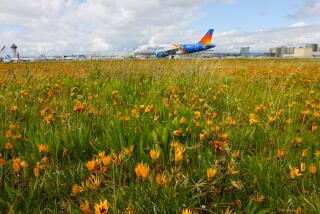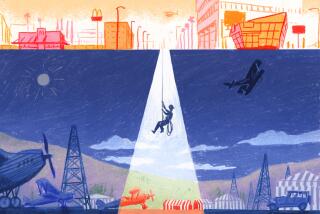‘Flight Path’ Honors Stars of Aviation
- Share via
Hollywood has its Walk of Fame, and Sepulveda Boulevard in Westchester is poised to take off as the “walk of planes”--the aviation equivalent of Tinseltown’s star-studded sidewalk.
Ten flight pioneers were honored Thursday in ceremonies on the city’s Flight Path, a sort of walk through aviation history that was unveiled last year in a mini-mall.
The names are legendary: Evelyn “Bobbi” Trout, contestant in the first women’s transcontinental race in 1929; Robert Hoover, test pilot and Chuck Yeager’s backup for the first supersonic flight in 1947; Tom Jones, retired Northrop Corp. chief and pioneer of low-cost, high-performance tactical aircraft.
Hoover and Jones were flying high as they reminisced about the 1973 Paris Air Show when Jones asked Rockwell’s Hoover to show what the Northrop F-58 could do.
“I knew that in Bob Hoover’s hands, that plane would steal the show,” Jones said.
It was one of Hoover’s greatest honors to be asked to fly a competitor’s plane. “Although we competed,” he said, “the airplane meant everything.”
At 73 Hoover still flies demonstrations. He likes planes with propellers because when he turns off the engines in midair, the audience can tell. That’s how he wows them, he said.
Trout, 90, is one of two surviving racers in what Will Rogers dubbed “The Powder Puff Derby.” Two forced landings in the first race in 1929 kept her from winning. She was the first woman to complete aerial refueling, and she also set speed records.
Once a site is selected, bronze plaques noting these pioneers’ aeronautical contributions will be embedded in Sepulveda Boulevard’s concrete.
Already lining one block in sight of LAX’s control tower are five tablets commemorating the Wright Brothers, Charles Lindbergh, Amelia Earhart, Yeager and Mines Field--the Los Angeles Municipal Airport named after the real estate agent who leased the 640 acres now known as LAX to the city.
The Flight Path’s point of embarkation, the Aviation Rotunda, is marked by a silhouette of a P-51 Mustang and a depiction of its cockpit. The plane, designed and manufactured in 100 days in 1940 by El Segundo’s North American Aviation, is a symbol of Southern California’s connection to flight. Plaques dedicated to “Dutch” Kindelberger, Donald Douglas, Jack Northrop and Howard Hughes mark the rotunda’s compass.
John Northrop, the son of the deceased aircraft designer, recalled his early fascination with planes.
“My dad trusted me enough so that I got to see some of them while they were still being developed,” he said “It was really Buck Rogers stuff, but I couldn’t say a thing to my friends or anybody. It was an exciting time.”
And it remains exciting for those who are following their paths. Vanessa Pereira, a 13-year-old student at Orville Wright Middle School, piloted a Piper last year to all 48 contiguous states. She flew, she said, to carry a message: “Aim high, work hard, don’t quit.”
Trout nodded in agreement.
More to Read
Sign up for The Wild
We’ll help you find the best places to hike, bike and run, as well as the perfect silent spots for meditation and yoga.
You may occasionally receive promotional content from the Los Angeles Times.






